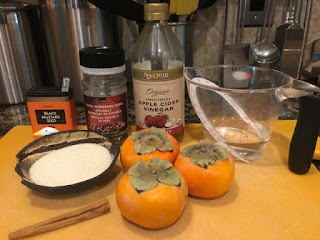I happened to see a FB post from another friend, Fariba, who said she had pickled some, so I asked her how she did it. Like me, she's an intrepid experimenter, so she said she just cuts them up, adds white vinegar and lots of herbs and spices (many Iranian), jars them up and lets them sit for 6-8 months depending if you like them soft or crunchy. I looked around for other recipes and saw that you can eat them within a week too. So, this is what I did.
ON THE CUTTING BOARD:

Fuyo persimmons, apple cider vinegar, water, black mustard seed, tricolor peppercorns, sugar, cinnamon stick.
STEP ONE:


Peel and chop the persimmons into cubes. I used three in this recipe.
STEP TWO:

Place 1/2 cup vinegar, 1/4 cup water, 2 T. sugar in a saucepan and heat until sugar dissolves. Let cool. Put persimmons in a clean jar, add the liquid along with a small cinnamon stick, 1/4 tsp. black mustard seeds and 1/4 tsp. peppercorns.
STEP THREE:

Store the jar in the refrigerator for a week and then enjoy!
I prepared this concoction last week and tasted them today. They were really good and soft the way I wanted them. I might use a little less vinegar next time. The contrast between sour and sweet was almost perfect but not quite. The beauty of this recipe is the freedom to explore with different flavors. I might add some herbs next time, maybe some ginger. Feel free to experiment. These pickled persimmons go well with cheese, pork, fish and probably a charcuterie plate. I'll try that next!
ALLA VOSTRA SALUTE!






























